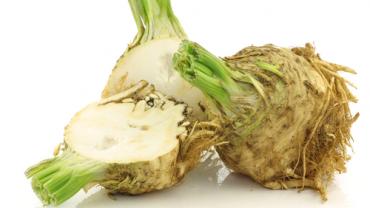
Thanks to creative cooks and food bloggers, there’s no shortage of low carb, Paleo, and ketogenic friendly substitutes for commonly beloved foods. Whether it’s mashed turnips, cauliflower “rice,” zucchini noodles, or jicama fries, people cutting back on starchy carbohydrates have a world of delicious substitutes to choose from. But after a few months—or years—of reduced carb intake, even the fanciest approximations can start to fall short. For those who are tired of cauliflower hummus or Brussels sprouts chips, consider adding celery root, aka celeriac, to the culinary repertoire.
Celeriac is one of the foods that often get ignored at farmers’ markets. It has an odd shape and can be pretty intimidating for someone who’s never cooked one before. (The same can be said of kohlrabi, another somewhat funny-looking vegetable that induces confusion and strange looks at the farmstand.) One clever writer said, “Imagine how celery root feels at the vegetable beauty pageant,” and indeed, she went on to group it together with the oft-shunned and less-than-pretty kohlrabi and rutabaga.
But celeriac need not be banished to the compost heap. It’s a tasty and versatile low carb vegetable whose main drawback is that its bulbous, knobby shape means it can be a pain to peel. (Use a knife rather than a vegetable peeler. Trying to get the skin off a celery root with a vegetable peeler is an exercise in futility, and also a good way to ruin a perfectly handy kitchen tool. Celery root can be peeled in similar fashion to a pineapple: cut off the top and bottom so that it sits upright, then cut away the rough sides. [Here’s a simple tutorial.])
And cutting celeriac is certainly worth it. Celeriac is similar to radishes in that it’s not exactly loaded with nutrients, but it’s definitely appropriate for low carb and Paleo diets. It provides a crunchy, refreshing and “earthy” bite when eaten raw, and the flavor mellows and sweetens a bit when cooked. And just because a food isn’t as nutrient-packed as liver or kale doesn’t mean it’s pointless to eat. (If that were the case, none of us would ever reach for a bag of potato chips or a chocolate cupcake!) Celery root might not be a vitamin and mineral powerhouse, but it’s not completely devoid of benefit. It’s a good source of vitamin K and provides small amounts of vitamin C, B6, phosphorus and potassium. A 100-gram serving (about 3.5 ounces) provides 9 grams of carbohydrate with 2 grams of fiber, for a net carb amount of just 7 grams and a very low glycemic load.
Celery root is native to the Mediterranean basin but is now grown in North America, Northern Europe, North Africa and Southwest Asia. It shares the flavor of the green celery stalks we’re more familiar with, although celeriac is much more mild. Despite the similar appearances of their stalks, celeriac is not the underground portion of common conventional celery. The two vegetables share the same genus and species (Apium graveolens) but celeriac is a unique variety (rapaceum) cultivated specifically for its root. It’s safe to eat the stalks of celeriac, but they’re typically discarded because they’re woody and not as appetizing as the usual celery. (The leaves, however, can be dried and then pulverized to use as a spice, which works well if you’re out of celery but a recipe would benefit from the flavor.)
Celery root can be eaten raw or cooked, but for the purposes of Paleo style recipes, it’s typically cooked. There are a surprising number of ways to use celeriac. For those whose love affair with all things cauliflower has begun to fade, there’s celeriac mash. Or how about celeriac fries? (Consider using crushed pork rinds to give them a crispier texture.) Boiled and pureed celeriac also makes a great soup, either on its own or combined with cauliflower. Celeriac can even be used to make keto and low carb friendly grits! For those who’d prefer to try celeriac in a cooler, more refreshing recipe befitting a summer or autumn picnic, pairing it with apple in a salad is classic—made even better with the addition of nuts and fresh herbs. If you’re feeling especially ambitious in the kitchen and would like to avoid all grain, not just ones that contain gluten, try your hand at these “waffle hash browns,” made with grated celeriac.
Just like with people, we shouldn’t judge a vegetable by its exterior. Next time you see a lonely, neglected celery root at the store, make its day by bringing it home with you.